User Tools
Actions if the building fire alarm activates:
- The designated Accelerator Operator shall:
- Check the annunciator panel for the location of the alarm (instructions on the panel below)
- Put in all faraday cups and shut down the accelerator
- Contact accelerator staff ASAP
- Wait for emergency personnel in the lobby and escort them to the location
- All other personnel are to evacuate the building as directed by the alarm system message
Actions if the annunciator panel reports Supervisory:
The designated Accelerator Operator shall:
- Immediately stop radiation production
- Check the annunciator for the nature of the trouble (instructions on the panel below)
- If the message is “DOCK or VAULT ECO SENSOR ALARM” this is a low oxygen event
- The VESDA computer should be playing a low oxygen message, check to see if the computer is reporting low oxygen.
- Check to see if the SF6 alarm and Tank Volume data support an SF6 leak
- Contact accelerator staff immediately
- Be prepared to go to the nearest fire alarm pull station to evacuate the building
- If the message is “XXXXXXXX VESDA PIPE X” This is a significant smoke detection
- Contact accelerator staff immediately
- Activate the Tritium Exhaust Fans
- Be aware that the building fire alarm may activate soon
Actions if the annunciator panel reports Trouble:
The designated Accelerator Operator shall:
- Immediately stop radiation production
- Check the annunciator for the nature of the trouble (instructions on the panel below)
- If the message is “XXXXXXXX VESDA PIPE X” This is an initial smoke detection
- Contact accelerator staff immediately
- Be aware that the Supervisory Trouble and then the building fire alarm may activate soon
…………………………………………………………………………….
General Information:
- Accelerator Personnel do not have any control over the main Fire Alarm Systems, we only have the ability to view information. Accelerator Personnel (Devon or Don) are, however, the primary technical support for the VESDA systems in the lab areas.
- If the fire alarm is in a condition other than normal, no radiation will be produced until the trouble is fixed, or until the requirements in the Interlock Rules Policy have been satisfied.
- Accelerator Personnel may use a fire extinguisher if the individual feels they can do so safely but there is no requirement to do so.
- Never open a door to an alarm area if smoke is visible outside the door or if the door is warm.
- OUPD dispatchers should get automatically notified of any trouble or fire alarm on the system.
The Annunciator Panel (located in the control room, photo below)
The control room annunciator is the only point where accelerator personnel have access to system information. The main panel and the front door panels are behind locked doors.
There are 4 possible conditions for the fire alarm system:
- System Normal: The LCD displays “sytem normal” and the date and time. The only LED illuminated is the green “power on” indicater. No sounds are being made.
- Fire Alarm: This is an emergency condition. All strobe lights in the building will be flashing, loud warning claxons will be playing, and a voice message will be directing people to leave the building through the front door. Police and Fire Department personnel will be on the way automatically. The control room annunciator will be making the whistling tone and the yellow fire alarm LED will be lit. The LCD will be displaying the number of alarm conditions present. Press the red “Alarm ACK” button to display the location of the alarm. Continue the press the Alarm ACK button to scroll through multiple alarm conditions. Call OUPD at 3-1911 to confirm that responders are on the way. Only the emergency responders will have the ability to silence and clear any alarms on the main fire panel at the base of the stairs. Only Devon and Don will be able the clear and reset alarms on the VESDA system, call them to make sure they are on the way.
- System Supervisory: This indicates that the system has detected a serious offnominal condition which may hinder its ability to function. This condition does not activate the strobe lights and claxons. The annunciator will be making a whistling tone and the yellow system supervisory LED will be lit. The LCD will be displaying the number of supervisory conditions present. Press the red “SUPV ACK” button to display the location of the problem. Continue the press the SUPV ACK button to scroll through multiple problem conditions. The OU facilities Maintenance personnel will have the ability to silence and clear any problems on the main fire panel, but Devon or Don will be required to address problems with the VESDA systems. Call OUPD at 3-1911 to request Facilities Maintenance, call Devon and Don.
- System Trouble: This indicates that the system has detected an offnominal condition which may hinder its ability to function. This condition does not activate the strobe lights and claxons. The annunciator will be making a whistling tone and the yellow system trouble LED will be lit (as shown in the photo). The LCD will be displaying the number of trouble conditions present. Press the red “TBL ACK” button to display the location of the problem. Continue the press the TBL ACK button to scroll through multiple problem conditions. The OU facilities Maintenance personnel will have the ability to silence and clear any problems on the main fire panel, but Devon or Don will be required to address problems with the VESDA systems. Call OUPD at 3-1911 to request Facilities Maintenance, call Devon and Don.
The Priority 2 alarm is not used in our system and we should not ever see such alarms.
The gray buttons and LEDs on the left side of the annunciator do nothing for us. The LEDs may illuminated during maintenance to indicate that certain functions are disabled for repairs.


